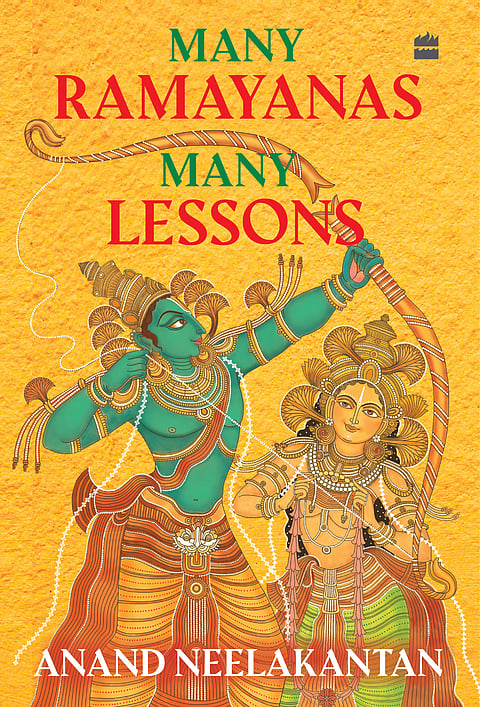

Long before Rama was deified, he was a human being with flaws. He was one with emotions — he was vocal in his love for Sita, he took steps outside of ‘dharma’ knowing the consequences, and he was also manipulated by people around him. This is how Valmiki intended Rama to be.
As the centuries turned, many Ramayanas emerged. While the structure of the epic remained the same, the characterisations differed. Across Asia, spanning cultures and languages, there were several retellings. In some, Sita is the daughter of Ravana; in others, it wasn’t Sita who was abducted or underwent the trial by fire but Maya-Sita. Folk versions altered it to suit the region or community. Then came the ‘Bhakti’ era, and the ‘Ramayana’ became a story of good versus evil.
In ‘Many Ramayanas, Many Lessons’, author Anand Neelakantan breaks down the epic and presents the different versions available, offering readers another perspective.
It is a culmination of all the versions he has heard over the years. Recalling the first rendition he heard that put him on the path to reading more about this epic, Anand shares, “The first rendition I encountered was the Malayalam version by Thunchath Ezhutachan. I was also exposed to ‘Ramayana’-based tales performed in temple art forms in Tripunithura. There used to be folk storytellers who visited the numerous temples in my hometown, offering yet another perspective on the ‘Ramayana’. However, when Ramanand Sagar’s ‘Ramayana’ aired on Doordarshan, I realised there were significant differences between the ‘Ramayana’ portrayed on television and the versions understood in other parts of the country. This piqued my interest at a very young age, and since then, it has been a lifelong fascination.”
Interestingly, ‘Many Ramayanas, Many Lessons’ was initially an audiobook that came out during the pandemic and was a worldwide hit. In the five years since, he has encountered more fascinating versions of the ‘Ramayana’ and incorporated them into this book. This process — of finding more versions and decoding further — Anand notes, is never-ending. “However, this is not a scholar’s book but a storyteller’s narrative. It can be read as a fascinating story, narrated in the style of an oral storyteller, with relevant deviations and interpretations, much like how the ‘Ramayana’ is always told in rural India,” he says. The book dedicates an entire section to sources and the versions available in different languages for readers who wish to explore further.
Personally, Anand is fascinated by the ‘Ramayana’ versions outside India and those belonging to Buddhist and Jain traditions. “Many of the versions outside India, as well as some Jain versions, depict Sita as the daughter of Ravana, which fundamentally alters how we perceive the story. The Shakteya version, where the ‘Ramayana’ is Sita-centric, is also incredibly different and fascinating,” he says.
The book not only familiarises readers with the different versions of the epic but also discusses some of the themes that have raised quite a few eyebrows and become topics of debate. For example, Lakshmana cutting off Shurpanaka’s nose, Rama slaying Bali by tricking him, and Sita being forced to undergo a trial by fire. “My idea was to highlight how various poets, ‘rishis’, and philosophers have addressed these plot points through different versions of the ‘Ramayana’. These incidents have been debated for thousands of years. No text or philosophy in India has gone unchallenged. There are no commandments of God that cannot be questioned in Indian thought. There is no infallible God or Gods for Indians,” he explains.
Another fascinating aspect Anand discusses is finding answers to some of the unanswered questions of the ‘Ramayana’ in the ‘Mahabharata’. Elaborating on this, Anand says, “The ‘Mahabharata’ has its own ‘Ramayana’, known as ‘Ramopakhyana’, which includes many details absent in other ‘Ramayana’s. Both the ‘Ramayana’ and ‘Mahabharata’ developed as ‘Dharma Shastras’, where the purpose of the story is to make people reflect on the nuances of Dharma. In Indian thought, the fruits of one’s Karma ripen sometimes in future births, leading many characters to experience their ‘Karmaphala’ (fruits of Karma) in their rebirths as ‘Mahabharata’ characters. Bali, who was killed by Rama, is reborn as Jara to take Krishna’s life in the ‘Mahabharata’. The ocean that Rama tamed to build the Rama Setu to Lanka returns to claim Dwaraka, Krishna’s city. The cyclical nature of Karma and ‘Janma’, and how it spares not even the ‘avataras’ of Vishnu, becomes evident when we read the ‘Mahabharata’ as a continuation of the ‘Ramayana’. This interconnectedness runs throughout all the ‘Puranas’.”
Ultimately, every step taken by every character in the Ramayana leads to a series of events. Be it Dasharatha granting boons to Kaikeyi, Rama and Lakshmana killing Tadaka, or the several immoral acts committed by Ravana that brought upon him eighteen curses, every action has a reaction. “The entire ancient thought can be simplified in one line – every Karma will have its ‘Karmaphala’. Ofcourse, there are texts that negate ‘Karma siddhanta’, but the ‘Ramayana’, ‘Mahabharata’, and other ‘Puranas’ use the theory of Karma as a foundation,” he signs off.